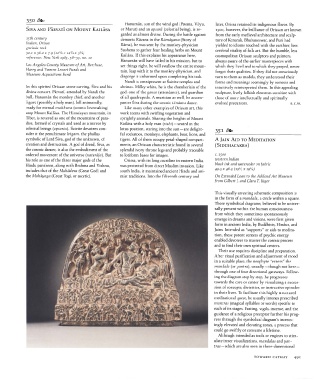Page 492 - Art In The Age Of Exploration (Great Section on Chinese Art Ming Dynasty)
P. 492
350
Hanuman, son of the wind god (Pavana, Vayu, later, Orissa retained its indigenous flavor. By
SIVA AND PARVATI ON MOUNT KAILASA or Marut) and an apsard (celestial being), is re- 1500, however, the brilliance of Orissan art known
garded as almost divine. During the battle against from the early medieval architecture and sculp-
i5th century demonic Ravana in the Rdmdyana (Story of ture of Konarak, Bhubaneswar, and Puri had
Indian, Orissa Rama), he was sent by the monkey-physician yielded to idioms touched with the earthier, less
gneissic rock Sushena to gather four healing herbs on Mount cerebral vitality of folk art. But the humble, less
5
2
2
32.1 X }6.2 X 7.9 (l2 /8 X 14 /4 X 3 /SJ Kailasa. If this explains his appearance here,
reference: New York 1985, 38-39, no. 10 cosmopolitan Orissan sculptors and painters,
Hanuman will have failed in his mission, but to always aware of the earlier masterpieces with
Los Angeles County Museum of Art, Purchase, set things right, he will swallow the entire moun- which they lived and to which they prayed, never
Harry and Yvonne Lenart Funds and tain, leap with it to the monkey-physician, and forgot their qualities. If they did not consciously
Museum Acquisitions Fund disgorge it unharmed upon completing his task. turn to them as models, they understood their
Nandi is omnipresent at Saivite temples and forms and meanings seemingly by osmosis and
In this spirited Orissan stone carving, Siva and his shrines. Milky white, he is the chamberlain of the intuitively reinterpreted them. In this appealing
divine consort, Parvati, attended by Nandi the god, one of the ganas (attendants), and guardian sculpture, lively folkish elements combine with
bull, Hanuman the monkey chief, and another of all quadrupeds. A musician as well, he accom- those of more intellectually and spiritually
figure (possibly a holy man), loll animatedly, panies Siva during the cosmic tdndava dance. evolved precursors. s. c. w.
ready for eternal maithuna (cosmic lovemaking) Like many other examples of Orissan art, this
atop Mount Kailasa. The Himalayan mountain, in work teems with swirling vegetation and
Tibet, is revered as one of the mountains of para- sprightly animals. Sharing the heights of Mount
dise, formed of crystals and used as a mirror by Kailasa with a holy man (rishi) — seated in the
celestial beings (apsaras). Saivite devotees con- lotus position, staring into the sun —are delight- 351
sider it the penultimate lingam, the phallus ful cockatoos, monkeys, elephants, boar, lions, and
symbolic of Lord Siva, god of the unknown, of tigers. All of them occupy petal-shaped compart- A JAIN AID TO MEDITATION
creation and destruction. A god of dread, Siva, as ments, an Orissan characteristic found in several (SIDDHACAKRA)
the cosmic dancer, is also the embodiment of the splendid ivory throne legs and probably traceable
ordered movement of the universe (natardja). But to lotiform bases for images. c. 1500
his role as one of the three major gods of the Orissa, with its long coastline in eastern India, western Indian
Hindu pantheon, along with Brahma and Vishnu, was protected from direct Muslim invasion. Like black ink and watercolor on fabric
includes that of the Mahddeva (Great God) and south India, it maintained ancient Hindu and ani- 49.5 x 48.9 (1^/2 x 19 ViJ
the Mahayoga (Great Yogi, or ascetic). mist traditions. Into the fifteenth century and On Extended Loan to the Ackland Art Museum
from Gilbert J. and Clara T. Yager
This visually arresting schematic composition is
in the form of a mandala, a circle within a square.
These symbolical diagrams, believed to be univer-
sally present within the human consciousness
from which they sometimes spontaneously
emerge in dreams and visions, were first given
form in ancient India, by Buddhists, Hindus, and
Jains. Intended as "supports" or aids to medita-
tion, these potent centers of psychic energy
enabled devotees to master the cosmic process
and to find their own spiritual centers.
Their use requires discipline and preparation.
After ritual purification and adjustment of mood
in a suitable place, the neophyte "enters" the
mandala (or yantra), usually —though not here —
through one of four directional gateways. Follow-
ing the diagram step by step, he progresses
towards the core or center by visualizing a succes-
sion of concepts, divinities, or instructive episodes
in their lives. To facilitate this highly structured
meditational quest, he usually intones prescribed
mantras (magical syllables or words) specific to
each of its stages. Fasting, vigils, incense, and the
guidance of a religious preceptor further his prog-
ress through the symbolical diagram's increas-
ingly elevated and elevating zones, a process that
could go swiftly or consume a lifetime.
Although intended as tools or engines to stim-
ulate inner visualizations, mandalas and yan-
tras—which are also seen in three-dimensional
TOWARD CATHAY 491

